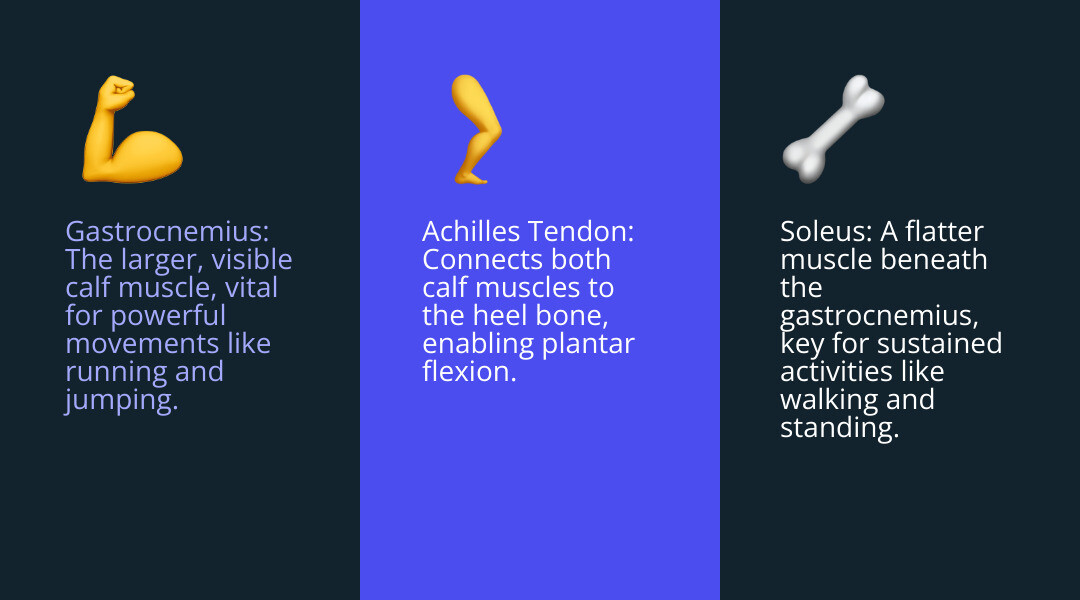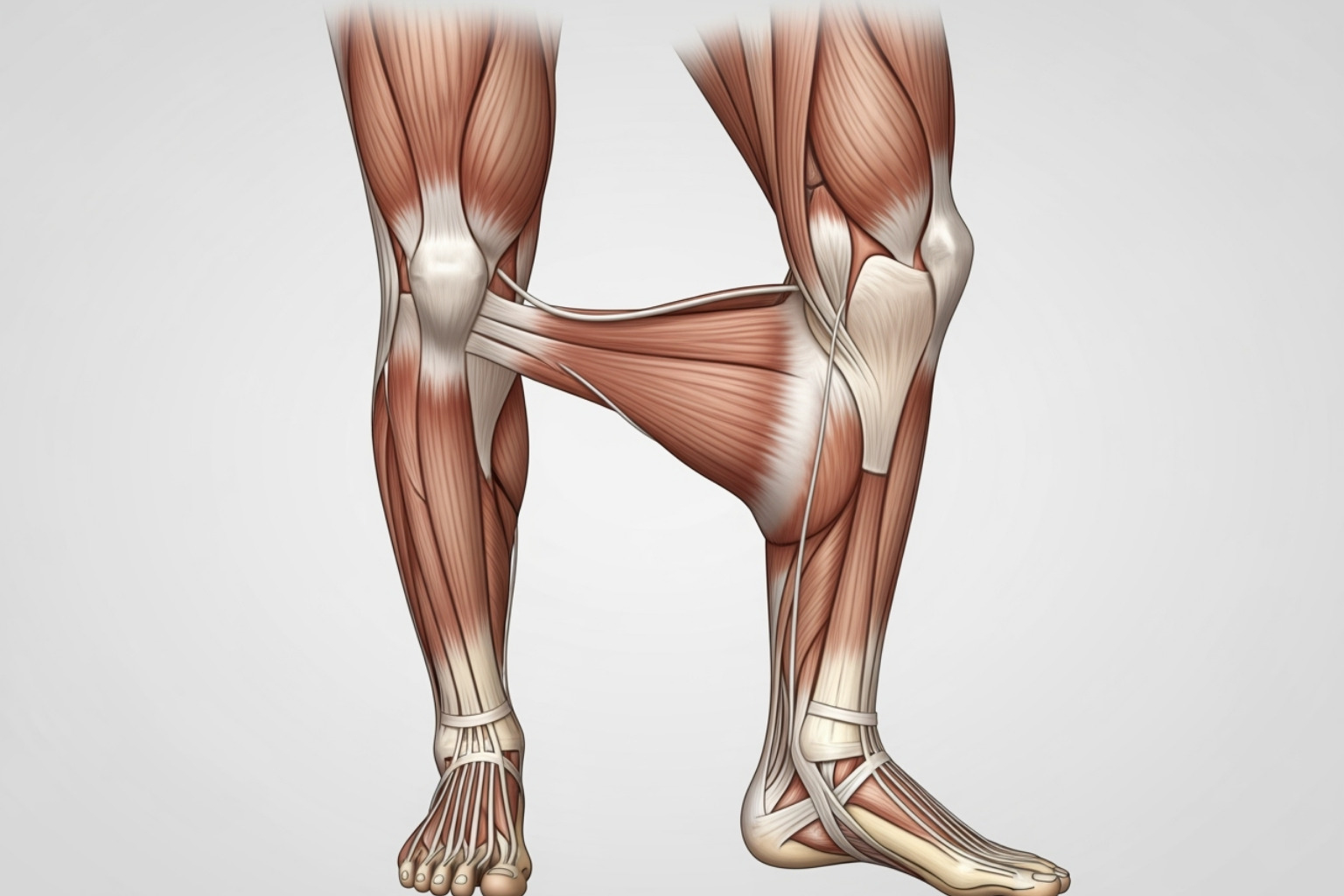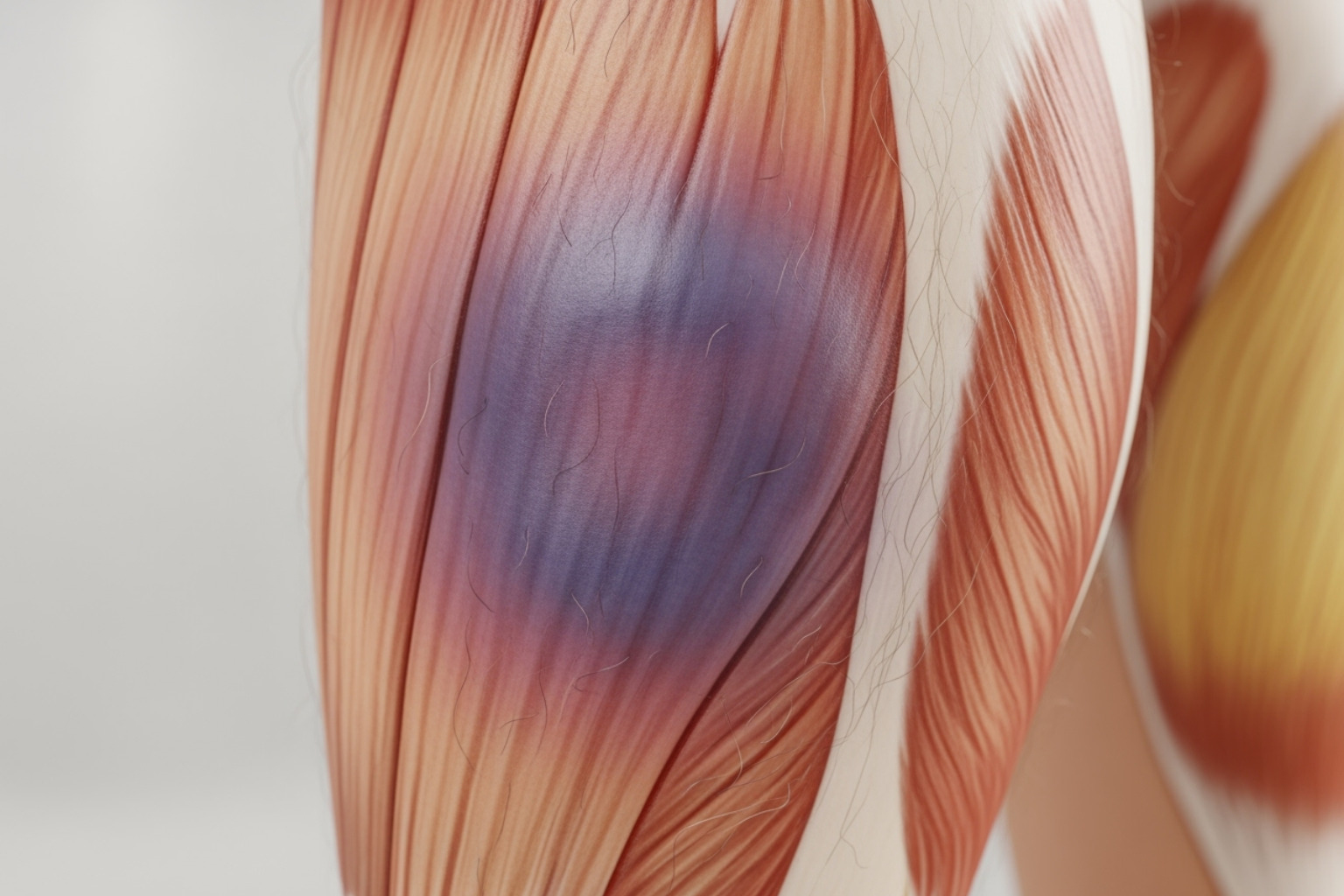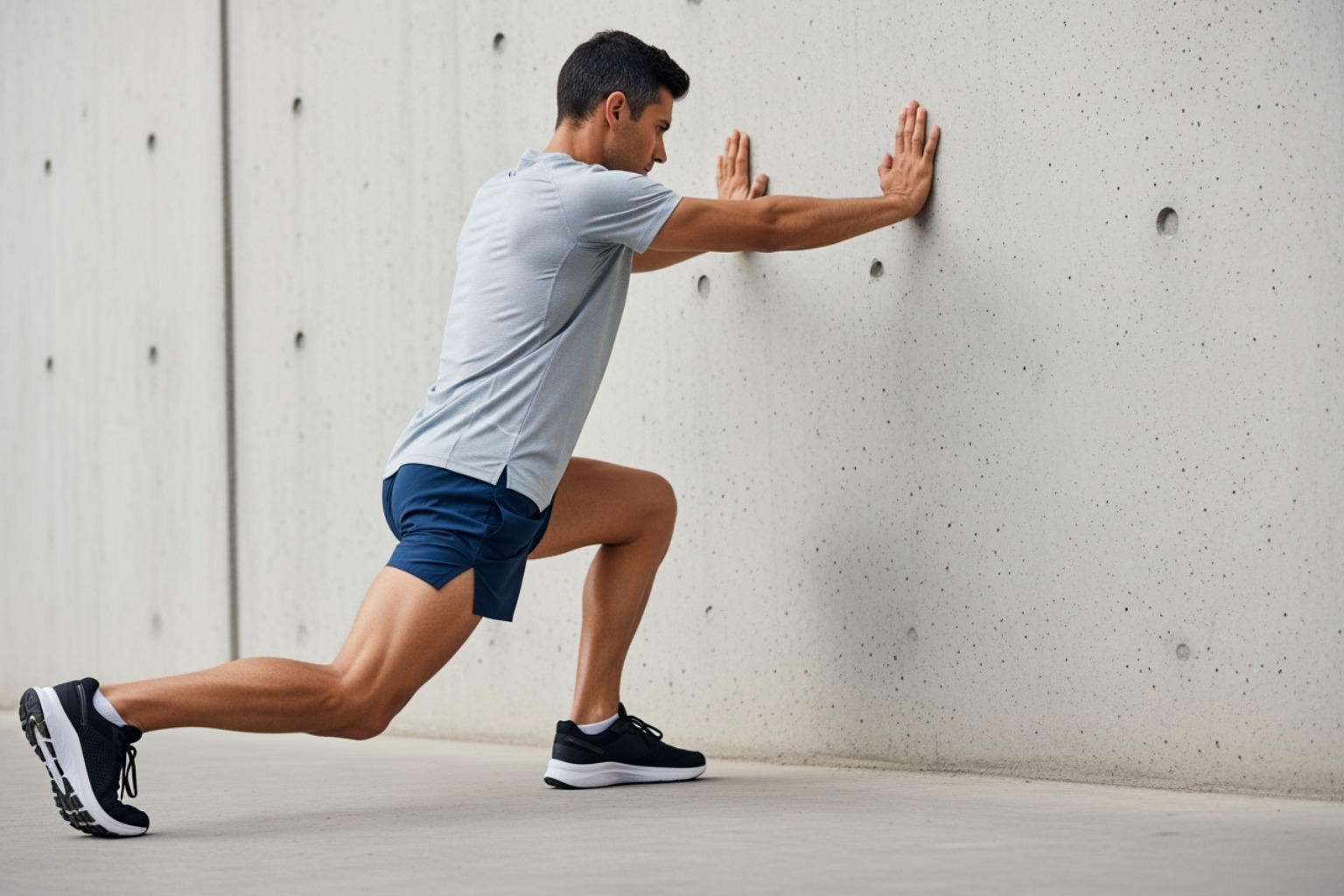Why Calf Muscles Hurt and What You Can Do About It
Calf muscles hurt for many reasons, from simple muscle cramps to serious conditions like blood clots. Understanding the cause is the first step to finding relief.
Quick Answer: Common Causes of Calf Pain
- Muscle Cramps or Strains: Caused by overuse, dehydration, or sudden movements.
- Achilles Tendinitis: Inflammation of the tendon connecting your calf to your heel.
- Deep Vein Thrombosis (DVT): A blood clot that requires immediate medical attention.
- Nerve Issues: Radiating pain from sciatica or diabetic neuropathy.
- Poor Circulation: Narrowed arteries reducing blood flow to your legs.
When to Seek Immediate Help: Contact a doctor right away if you experience sudden severe pain, swelling in one leg with warmth and redness, inability to walk, or shortness of breath. Research shows that up to 10% of people with symptoms of calf pulls actually have DVT, which can be life-threatening [4].
Calf pain affects everyone, from athletes to office workers. The good news is that most issues can be managed with proper care. Your calf contains two main muscles: the large, powerful gastrocnemius and the deeper, endurance-focused soleus. Both connect to your heel via the Achilles tendon. When any part of this system is strained or injured, you feel it.
I'm Tony Enrico, and through my work with Neuropasil, I've helped many people manage pain when their calf muscles hurt. This guide provides clear, actionable information for your recovery.

Understanding Your Calf Muscles and Why They Hurt
Your calves work hard every time you walk, run, or jump. When your calf muscles hurt, it's often because they've been pushed too far. The back of your lower leg has two main muscles: the gastrocnemius, the large, visible muscle responsible for explosive movements like sprinting, and the soleus, a flatter muscle underneath that acts as your endurance champion for walking and standing.
Together, these muscles (the triceps surae) connect to your heel via the Achilles tendon. Their main job is plantar flexion—pointing your toes downward. When something goes wrong with these muscles, tendons, or the surrounding nerves and blood vessels, you feel pain [1].

Common Muscular Causes of Calf Pain
Most of the time, when your calf muscles hurt, the cause is muscular.
- Muscle cramps ("charley horses") are sudden, involuntary contractions often caused by muscle overexertion, dehydration, or electrolyte imbalances. While they pass quickly, the soreness can linger [2].
- A muscle strain (pulled calf) occurs when muscle fibers stretch or tear, common in activities requiring sudden power. A mild strain causes discomfort, while a severe tear can make it impossible to bear weight.
- Delayed Onset Muscle Soreness (DOMS) is the dull ache that appears 24-72 hours after a tough workout. It's a sign your muscles are adapting and getting stronger.
- Achilles tendinitis is an overuse injury causing a dull ache in the back of the lower leg, often worse after activity or in the morning. It develops gradually from a sudden increase in exercise intensity.
Vascular and Neurological Reasons Your Calf Muscles Hurt
Sometimes, calf pain signals a problem with blood vessels or nerves, which may require medical attention. All forms of leg pain should be taken seriously.
- Deep Vein Thrombosis (DVT) is a blood clot in a deep vein, usually the calf. It's a medical emergency, as the clot can travel to the lungs. Look for swelling, warmth, redness, and pain in one leg. Up to 10% of people who think they have a pulled calf actually have DVT [4].
- Varicose veins are swollen, twisted veins that can cause throbbing, cramping, and aching in the calves due to blood pooling.
- Arterial claudication causes calf pain that starts with activity (like walking) and stops with rest. It's due to narrowed arteries restricting blood flow.
- Sciatica occurs when the sciatic nerve is pinched in the lower back, causing pain, tingling, or numbness to radiate down the leg and into the calf.
- Diabetic neuropathy is nerve damage from high blood sugar, causing shooting pain, tingling, or a burning sensation in the calves and feet [3].
- Compartment syndrome is a painful condition where pressure builds within a muscle compartment, compressing nerves and blood vessels. It can cause severe pain, swelling, and numbness, especially during exercise.
Identifying the Problem: Symptoms and Diagnosis
When your calf muscles hurt, the type of pain and other symptoms can help identify the cause. A sudden, sharp pain often signals a strain or cramp, while a dull, persistent ache may point to overuse, DOMS, or tendinitis. Pay attention to other signs:
- Tightness or stiffness is common with cramps and strains.
- Swelling indicates inflammation from a strain, DVT, or compartment syndrome.
- Bruising suggests internal bleeding from a tear or direct impact.
- Weakness or inability to stand on your toes may mean a significant strain or nerve issue.
- A popping sensation at the time of injury can accompany a muscle tear or Achilles rupture.
- Burning, tingling, or numbness points toward nerve involvement like sciatica or neuropathy.
For a broader look at muscle discomfort, see our guide on Muscle Aches.

When to See a Doctor for Calf Pain
While most calf pain resolves with home care, some symptoms are red flags that require immediate medical attention.
See a doctor right away if you experience:
- Severe or sudden pain without an obvious cause
- Inability to bear weight or walk
- Redness, warmth, and swelling in one leg (classic signs of DVT)
- A cool or pale calf, suggesting a circulation problem
- Fever with your calf pain
- Shortness of breath or chest pain (call emergency services)
- Pain that doesn't improve after several days of home care
- Persistent weakness, tingling, or numbness
Up to 10% of suspected calf pulls are actually DVT [4], making these warning signs critical.
How Doctors Diagnose Why Your Calf Muscles Hurt
A doctor will start with a physical examination and review your medical history, asking about your pain and symptoms. They will check for tenderness, swelling, and assess your strength and range of motion.
Based on this, they may order diagnostic tests:
- Musculoskeletal Ultrasound: This is often the first test used to see soft tissue injuries like strains, tendinitis, and blood clots (DVT).
- MRI Scan: Provides detailed images of muscles, tendons, and nerves to assess the extent of an injury.
- X-ray: Rules out bone fractures or other skeletal issues.
- Blood Tests: Can detect signs of infection, inflammation, or underlying conditions like diabetes. A D-dimer test can help rule out DVT [7].
Effective Treatments for Calf Pain Relief
Once you know why your calf muscles hurt, you can find the right relief. Most calf pain responds well to treatment, often starting with simple home care. For help choosing the right products, see our guide to the Best Products for Muscle Pain.
At-Home Care and the R.I.C.E. Method
For muscular strains and minor injuries, the R.I.C.E. method is your first line of defense:
- Rest: Stop the activity that caused the pain to allow the muscle to heal.
- Ice: Apply a cold pack wrapped in a towel for 15-20 minutes every few hours to reduce pain and swelling [5].
- Compression: Use an elastic bandage to minimize swelling and support the muscle.
- Elevation: Prop your leg above heart level to help drain excess fluid.
In the first 48-72 hours, also avoid H.A.R.M. (Heat, Alcohol, Running, Massage), as these can worsen the injury. For cramps, gentle stretching and hydration are key. Over-the-counter NSAIDs like ibuprofen can help manage pain and inflammation.
Neuropasil and Topical Solutions
As you heal, a physical therapist can help you rebuild strength and flexibility. They may also recommend supportive devices like crutches or a walking boot.
For managing daily discomfort, topical pain relief creams offer targeted relief. This is where Neuropasil shines. Our natural formula combines Aloe, Urea, and Menthol for fast-acting, soothing comfort. The menthol creates a cooling sensation that interrupts pain signals and relaxes tense muscles.
Many athletes and customers use Neuropasil when their calf muscles hurt from strains, overuse, or nerve-related pain like sciatica. You apply it directly to the painful area for targeted relief without the systemic side effects of oral medications. The non-greasy formula absorbs quickly so you can get on with your day. Learn more about Topical Pain Relief Options.
| Feature | Home Remedies (R.I.C.E., Oral NSAIDs) | Neuropasil Topical Relief (Menthol-based Cream) |
|---|---|---|
| Application | General body relief for oral NSAIDs; external for R.I.C.E. | Targeted, direct application to the painful area |
| Speed of Relief | Oral NSAIDs take time to absorb; R.I.C.E. reduces symptoms over time | Often fast-acting due to direct absorption at the site of pain |
| Side Effects | Oral NSAIDs can have systemic side effects (stomach, kidneys) | Minimal systemic side effects; localized skin reactions possible |
| Mechanism | Reduces inflammation (NSAIDs); reduces swelling/supports healing (RICE) | Cooling sensation (menthol), soothing, supports local blood flow |
| Best For | Acute injuries, general pain/inflammation | Localized muscle aches, strains, cramps, nerve pain, post-workout soreness |
| Neuropasil Benefits | N/A | Natural ingredients (Aloe, Urea, Menthol), fast-acting, non-greasy |
Severe injuries, persistent DVT, or compartment syndrome may require surgical intervention or specialized medical care [8]. Your doctor will guide you through these options if they become necessary.
How to Prevent Calf Pain and Future Injuries
The best way to deal with calf pain is to prevent it from happening. Adopting smart habits can significantly reduce your risk of strains and cramps.

- Warm-Up and Cool-Down: Always warm up with light cardio and dynamic stretches (like leg swings) before exercise. Afterward, cool down with static stretches, holding each for 20-30 seconds [6].
- Strengthen Your Calves: Strong calves are less prone to injury. Perform calf raises regularly, both with straight legs (for the gastrocnemius) and bent knees (for the soleus).
- Wear Proper Shoes: Well-fitting, supportive footwear prevents unnecessary strain. Replace worn-out athletic shoes every 300-500 miles [9].
- Stay Hydrated and Nourished: Dehydration is a leading cause of cramps. Drink plenty of water and ensure your diet includes electrolytes like potassium and magnesium.
- Progress Gradually: Avoid doing too much, too soon. Increase the intensity and duration of your workouts slowly to allow your body to adapt.
- Listen to Your Body: If your calf muscles hurt during an activity, it's a signal to stop or modify what you're doing. Pushing through pain can turn a minor issue into a major injury.
Managing underlying health conditions like diabetes or circulatory issues with your doctor is also crucial for preventing calf problems. Find more tips in our article on the best ways to relieve muscle aches.
Frequently Asked Questions about Calf Pain
When your calf muscles hurt, it's natural to have questions. Here are answers to the most common ones.
Should I walk if my calf hurts?
It depends on the severity. For mild soreness (like DOMS), gentle walking can help by increasing blood flow and reducing stiffness. However, if you have moderate to severe pain, or if it's accompanied by swelling, redness, or warmth, you should rest. Walking on a significant strain can worsen the injury. If there's any chance of DVT, walking could be dangerous. If it hurts to walk, stop and seek medical advice.
Can dehydration cause calf pain?
Absolutely. Dehydration is a primary cause of muscle cramps. When you're dehydrated, you lose water and essential electrolytes (sodium, potassium, magnesium) that your muscles need to contract and relax properly. This imbalance can lead to involuntary, painful spasms [2]. To prevent this, drink water consistently throughout the day, especially around physical activity.
What is the fastest way to heal a calf strain?
There's no magic bullet for instant healing, and rushing the process often leads to re-injury. The fastest effective way to heal is to be patient and systematic.
- Immediate R.I.C.E.: For the first 48-72 hours, use Rest, Ice, Compression, and Elevation to control inflammation.
- Get a Proper Diagnosis: See a healthcare professional to understand the severity of your strain.
- Manage Pain: Use over-the-counter NSAIDs or a targeted topical cream like Neuropasil for soothing relief.
- Gradual Rehabilitation: Once the acute phase passes, work with a physical therapist on gentle stretching and strengthening exercises to rebuild resilience without re-injuring the muscle.
Recovery time depends on the strain's severity: a mild strain may take 1-2 weeks, while a severe tear could take several months [10]. Listening to your body and your doctor is the surest path to a full recovery.
Conclusion
Calf pain is your body's way of signaling that something is wrong. We've covered the anatomy of your calf, the spectrum of causes from simple strains to serious conditions like DVT, and the importance of knowing when to see a doctor. Symptoms like swelling, warmth, and redness in one leg require immediate medical attention.
Fortunately, most cases where calf muscles hurt can be managed effectively. The R.I.C.E. method is crucial for acute injuries, and a proper diagnosis will guide your treatment. For targeted relief from muscle strains, cramps, or nerve-related discomfort, Neuropasil's natural topical formula offers fast-acting support that many people trust for their recovery.
Prevention is your most powerful tool. Proper warm-ups, strengthening exercises, good hydration, and listening to your body can keep your calves healthy and pain-free for years to come.
Whether you're an athlete or just want to walk comfortably, treating your calves with respect is key. For targeted, soothing relief to support your recovery journey, turn to Neuropasil's natural topical formula.
Learn more about managing Muscle Pain.
References
This article draws on information from trusted medical and scientific sources to ensure accuracy.
Complete Reference List:
[1] NLM (NCBI Bookshelf). Anatomy, Bony Pelvis and Lower Limb, Calf. Available at: https://www.ncbi.nlm.nih.gov/books/NBK459362/
[2] Mayo Clinic. Muscle Cramp. Available at: https://www.mayoclinic.org/diseases-conditions/muscle-cramp/symptoms-causes/syc-20350820
[3] National Institute of Diabetes and Digestive and Kidney Diseases. Diabetic Neuropathy. Available at: https://www.niddk.nih.gov/health-information/diabetes/overview/preventing-problems/nerve-damage-diabetic-neuropathies/what-is-diabetic-neuropathy
[4] PubMed. The 'tennis leg'. Available at: https://pubmed.ncbi.nlm.nih.gov/12091669/
[5] Cleveland Clinic. How to Use Ice on an Injury. Available at: https://health.clevelandclinic.org/how-long-to-ice-an-injury
[6] Harvard Health Publishing. The importance of stretching. Available at: https://www.health.harvard.edu/staying-healthy/the-importance-of-stretching
[7] Cleveland Clinic. D-Dimer Test. Available at: https://my.clevelandclinic.org/health/diagnostics/23022-d-dimer-test
[8] Mayo Clinic. Deep vein thrombosis (DVT). Available at: https://www.mayoclinic.org/diseases-conditions/deep-vein-thrombosis/diagnosis-treatment/drc-20352563
[9] American Academy of Podiatric Sports Medicine. General Running Shoe Recommendations. Available at: https://www.aapsm.org/runshoe.html
[10] Cleveland Clinic. Pulled Calf Muscle. Available at: https://my.clevelandclinic.org/health/diseases/21623-pulled-calf-muscle














